C.P. Goerz 12x PrismenfernrohrDieses 12x35 Monokular von Goerz Berlin hat einen 18,8cm langen Objektivtubus und ist ein militärisches Fernrohr für Artillerie-Beobachtungsstände. Es hat eine Verdickung am Tubus, an der eine Befestigungsschelle mit Montageplatte saß (s. 2. Exemplar). Auch das halbrunde eher kleine Prismengehäuse, wie es Goerz für Visiere oder ähnliche Instrumente (vgl. Visier 2,5x14 oder Fixfokus 3x15 Monokular) nutzte, weisen auf ein Richt- oder Peilfernrohr hin. Soweit es in dem abgebildeten Foto tatsächlich zu sehen ist, wurde es auch zum Ausrichten und Beobachten der Signale eines Blinkgerätes genutzt.Die Messingteile sind schwarz lackiert, die Augenmuschel ist aus Bakelit. Die Dioptrienskala reicht von plus bis minus Acht. Der obere Deckel ist mit dem Goerz-Logo und "12x" beschriftet; ein weiteres Exemplar ist mit "C.P. Goerz Wien u. Pozony No21" markiert. Der untere Deckel ist nierenförmig und steht am Prismengehäuse über, dient jedoch so als Verbindungsplatte zum Objektivtubus. Der österreichischen (K.u.K.) Druckschrift zu "Zusammenstellung der gegenwärtig in Verwendung stehenden optischen Instrumente" von 1918 weist es als Fernrohr an einem Richtapparat mit 14facher Vergrößerung aus (s. letztes Bild). |
C.P. Goerz 12x Prism TelescopeThis 12x35 monocular by Goerz Berlin has a 18.8 cm long objective tube. It was a military telescope used on artillery observation stations It has a thicker part on the tube which came with a mounting clamp (see 2nd piece). Moreover, the small half-circular prism housing which Goerz used for their target sights or similar instruments (cf. 2.5x14 sight or Fixfocus 3x15 Monocular) hint to a director or aiming sight. As far as one can see in the photo below, it was used for aligning and also observing signal devices.The brass parts are lacquered black, the eyecup is made of Bakelite. The dioptre scale ranges from plus to minus eight. The top cover is inscribed with the Goerz logo and "12x". Another model is marked "C.P. Goerz Wien u. Pozony No21". The bottom cover has a kidney shape palte protruding over the prism housing, but serves as a connecting plate to the objective tube in that way. The Austrian (K.u.K.) booklet on "Zusammenstellung der gegenwärtig in Verwendung stehenden optischen Instrumente" (Compilation of the optical instruments currently in use) of 1918 identifies it as a scope on a direction apparatus with a 14x magnification (cf. last pciture). |

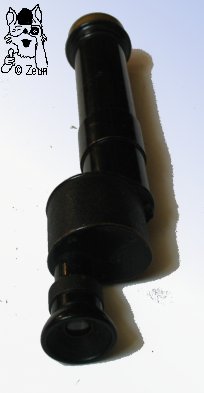
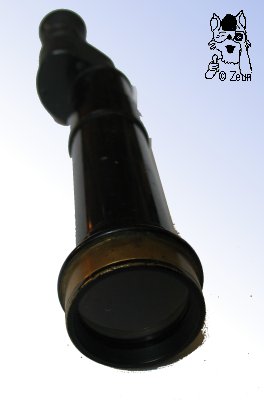
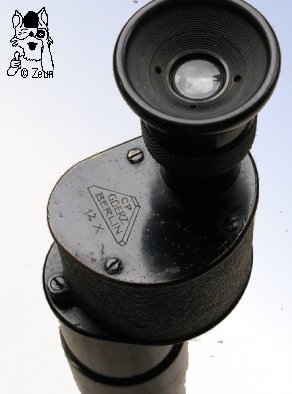

| Das Prismenfernrohr ist 272-278mm lang, das Prismengehäuse ist 50x39mm breit und 40mm hoch. Der Objektivtubus ist zunächst 34mm, an der Vedickung 40mm, danach 36mm und an der blanken Objektivfassung 42mm im Durchmesser. Die Augenmuschel hat einen Durchmesser von 35mm. Das Prismennmonokular wiegt 663g bzw. beim 2. Modell mit Befestigungsplatte 715g . | The prism scope is 272-278mm in length. Its prism housing is 50x39mm wide and 40mm tall. The objective tube starts with a 34mm diameter, being 40mm at the wider middle part, then increasing to 36mm in daimeter, and finally ending with a 42mm diameter at the blank objective frame. The eyecup measures 35mm in daimeter. Weight is 663g, and 715g for the second specimen with the mounting plate. |
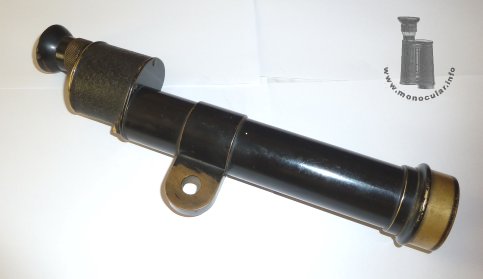
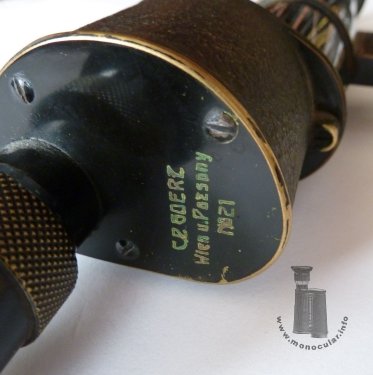
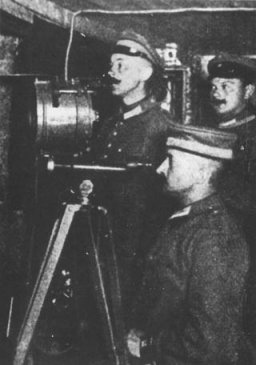
.jpg)
Fotos: Zeun

